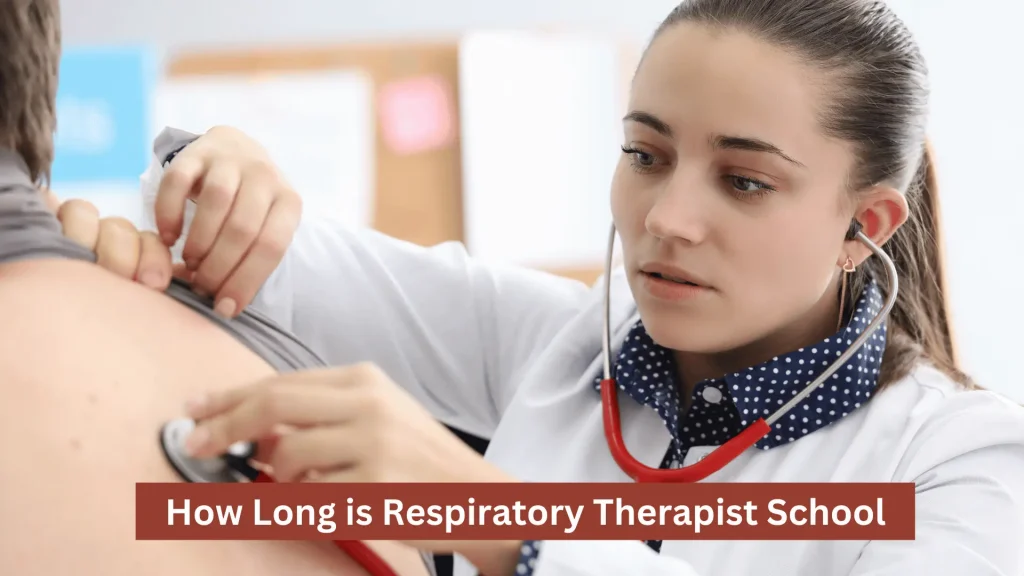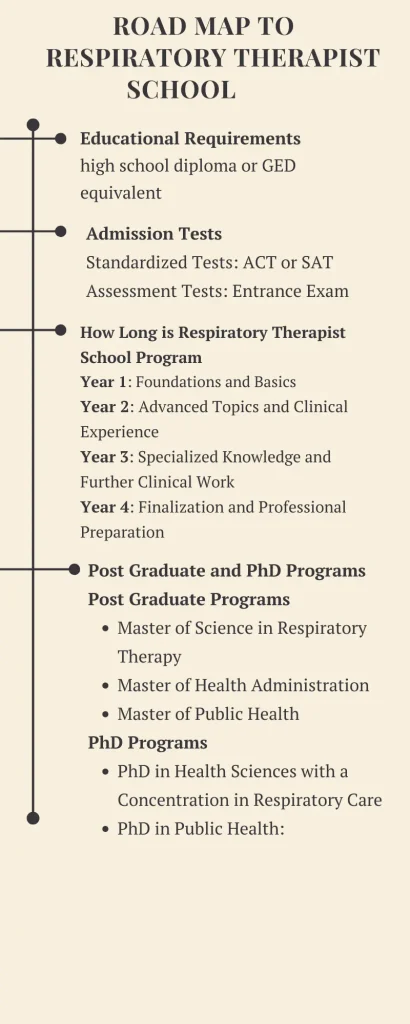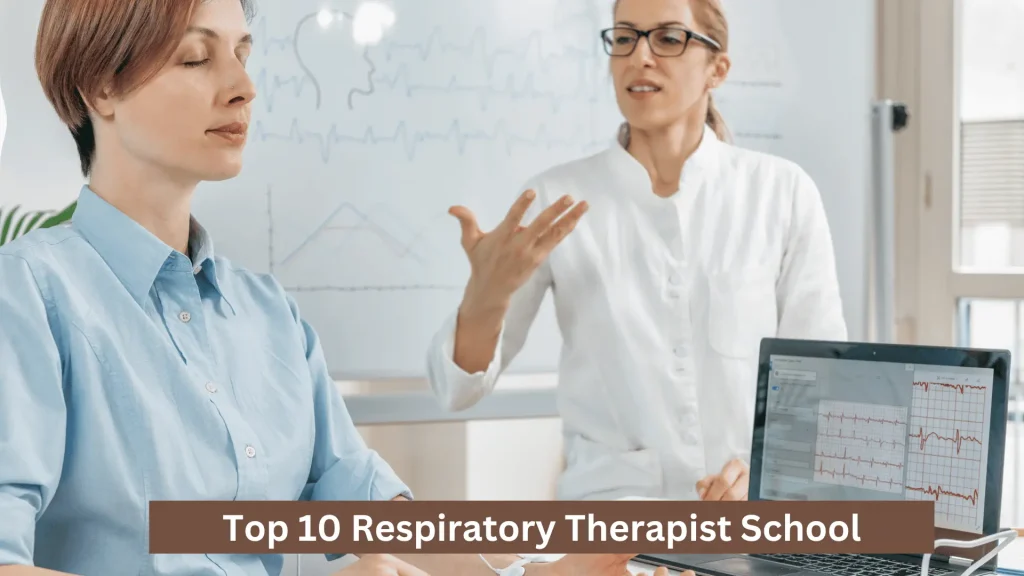How Long is Respiratory Therapist School
How Long is Respiratory Therapist School? Typically, respiratory therapy programs can take about two years to complete if you pursue an associate degree. If you opt for a bachelor’s degree, it can take around four years. The duration depends on the specific program and institution you choose.
What is Respiratory Therapist School:
Respiratory therapist school provides specialized education and training for individuals aiming to become respiratory therapists. These programs cover subjects such as anatomy, physiology, pharmacology, and respiratory care techniques. Students also gain hands-on experience through clinical practice in hospitals and healthcare settings.

Graduates of respiratory therapist programs are equipped to assess, treat, and care for patients with breathing or cardiopulmonary disorders. They learn to operate and maintain respiratory equipment, conduct diagnostic tests, and collaborate with healthcare teams to develop effective treatment plans. This education prepares them for certification and entry into the healthcare workforce.
How Long is Respiratory Therapist School
Year 1: Foundations and Basics
Courses: Introduction to Respiratory Therapy, Basic Anatomy and Physiology, Medical Terminology, Patient Care Principles.
Skills: Understanding the basics of respiratory care, developing patient interaction skills.
Clinical Practice: Initial exposure to clinical environments, observation, and basic hands-on practice.
Year 2: Advanced Topics and Clinical Experience
Courses: Advanced Respiratory Therapy Techniques, Cardiopulmonary Physiology, Pharmacology for Respiratory Care, Mechanical Ventilation.
Skills: Advanced patient care, handling complex respiratory conditions, using sophisticated equipment.
Clinical Practice: Extensive hands-on practice in hospitals and clinics, working directly with patients under supervision.
Year 3: Specialized Knowledge and Further Clinical Work (for Bachelor’s Degree)
Courses: Pediatric and Neonatal Respiratory Care, Pulmonary Rehabilitation, Respiratory Care Management, Research Methods in Respiratory Care.
Skills: Specialized respiratory care techniques, research and data analysis, leadership and management in healthcare settings.
Clinical Practice: Specialized clinical rotations, independent patient care responsibilities, and possibly research projects.
Year 4: Finalization and Professional Preparation (for Bachelor’s Degree)
Courses: Advanced Clinical Practices, Capstone Projects, Health Policy and Ethics in Respiratory Care.
Skills: Mastery of clinical skills, ethical decision-making, preparation for board exams and certification.
Clinical Practice: Final clinical rotations, preparation for entering the workforce, job placement assistance.

How to Enter Respiratory Therapist School
Educational Requirements for Respiratory Therapist School
High School Diploma or GED: Required for admission to undergraduate programs.
Prerequisite Courses: Biology, Chemistry, Mathematics, and English.
Minimum GPA: Varies by program, but often a minimum of 2.5-3.0.
Entry Tests for Respiratory Therapist School
Standardized Tests: SAT or ACT scores may be required.
Entrance Exams: Some programs may require specific health sciences entrance exams.
Application Process for Respiratory Therapist School
Application Form: Complete and submit the application through the school’s admissions portal.
Transcripts: Provide high school and any previous college transcripts.
Letters of Recommendation: Usually required from teachers or professionals in the healthcare field.
Personal Statement: Explain your interest in respiratory therapy and career goals.
Interview: Some programs may require an interview as part of the selection process.
Financial Aids for Respiratory Therapist School
Scholarships: Merit-based and need-based scholarships specific to healthcare or respiratory therapy students.
Grants: Federal and state grants such as Pell Grants.
Student Loans: Federal student loans (Direct Subsidized/Unsubsidized Loans) and private loans.
Work-Study Programs: Part-time work opportunities provided by the school to help cover expenses.
Financial Aid Office: Assistance in finding and applying for various financial aid options.
Post Graduate and PhD Programs for Respiratory Therapist School
Postgraduate Programs:
Master of Science in Respiratory Therapy (MSRT):
Duration: Typically 2 years.
Focus: Advanced clinical practice, leadership, education, and research.
Courses: Advanced Respiratory Care Techniques, Healthcare Management, Research Methods, and Education Methods.
Master of Health Administration (MHA):
Duration: Typically 2 years.
Focus: Management and administration in healthcare settings.
Courses: Healthcare Policy, Health Informatics, Financial Management in Healthcare, and Strategic Planning.
Master of Public Health (MPH):
Duration: Typically 2 years.
Focus: Public health principles and practices.
Courses: Epidemiology, Biostatistics, Environmental Health, and Health Policy and Management.
PhD Programs:
PhD in Health Sciences with a Concentration in Respiratory Care:
Duration: 3-5 years.
Focus: Advanced research, academic teaching, and leadership in respiratory care.
Courses: Advanced Research Methods, Biostatistics, Advanced Respiratory Care, and Dissertation Research.
PhD in Public Health:
Duration: 3-5 years.
Focus: Research and teaching in public health with a focus on respiratory health.
Courses: Epidemiology, Public Health Theory, Research Methods, and Dissertation Research.
Top 10 Respiratory Therapist Schools
To create a list of the top 10 respiratory therapist schools, we’d typically look at factors such as program reputation, accreditation, faculty expertise, clinical opportunities, and graduation rates. Here’s a generalized list based on these criteria:

University of California, San Francisco (UCSF) – Known for its comprehensive respiratory care program and cutting-edge research.
Johns Hopkins University – Offers a renowned respiratory therapy program with a focus on clinical excellence and research.
Ohio State University – Strong program with a variety of clinical rotations and research opportunities.
University of Pittsburgh – Offers a well-established respiratory therapy program with strong clinical affiliations.
Texas State University – Known for its rigorous respiratory care curriculum and strong clinical training.
Rush University – Offers a top-tier respiratory therapy program with a focus on patient care and innovation.
Loma Linda University – Provides a comprehensive respiratory therapy program with a strong emphasis on clinical practice.
University of North Carolina at Chapel Hill – Known for its accredited respiratory care program and extensive clinical partnerships.
Stony Brook University – Offers a reputable respiratory therapy program with a strong clinical component.
Georgia State University – Known for its diverse respiratory therapy curriculum and research opportunities.
Factors Affecting the Length of Respiratory Therapist School
Type of Degree:
Associate Degree: Typically takes 2 years to complete.
Bachelor’s Degree: Generally takes 4 years to complete.
Program Structure:
Full-Time vs. Part-Time: Full-time programs take less time than part-time programs.
Accelerated Programs: Some schools offer accelerated programs that can shorten the duration.
Clinical Requirements:
Clinical Hours: Programs with more extensive clinical requirements may take longer to complete.
Clinical Placement Availability: Delays in clinical placements can extend the program duration.
Prerequisite Courses:
Completion of Prerequisites: Students may need to complete prerequisite courses before starting the core respiratory therapy program, adding to the overall time.
Transfer Credits:
Acceptance of Previous Credits: Transfer of credits from previous education can shorten the program length.
School Policies:
Curriculum Design: Differences in curriculum design and credit requirements between schools can affect program length.
Student’s Pace:
Individual Pace: Some students may take longer to complete the program due to personal circumstances or part-time enrollment.
State Licensing Requirements:
Additional State Requirements: Some states may have additional licensing requirements that could extend the duration of education and training.
These factors collectively influence the length of time required to complete respiratory therapist school, varying from student to student and program to program.
Final Verdict
Deciding on a career as a respiratory therapist involves understanding the duration of the educational process and exploring advanced opportunities. By choosing the right program and meeting essential requirements, you can embark on a rewarding career in respiratory care. Prepare for the challenges and opportunities in this vital healthcare field.
FAQs
How long does it take to complete a respiratory therapist program?
It typically takes 2 years for an associate degree and 4 years for a bachelor’s degree.
What are the educational requirements for respiratory therapist school?
You need a high school diploma or GED, and completion of prerequisite courses such as biology and chemistry.
What types of entry tests are required for respiratory therapist programs?
Standardized tests like the SAT or ACT may be required, and some programs might have additional health sciences entrance exams.
What is the application process for respiratory therapist school?
Submit an application form, transcripts, letters of recommendation, a personal statement, and possibly attend an interview.
What financial aid options are available for respiratory therapist school?
You can apply for scholarships, grants, student loans, and work-study programs to help cover the cost of your education.
